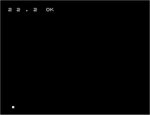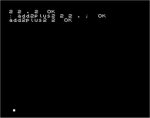UK Computers 1978 to 1989
In a way I had been dreading this one for reasons which will become obvious. In many ways, the Jupiter Ace is like a cross between a Spectrum and a ZX81. It looks a little like the Spectrum, had rubber keys (though not the keyword entry system) but lacks colour and proper high-resolution graphics. The Jupiter Ace devoted 2K of memory to its display leaving just 1K for programs (expandable to 49K) but this was often enough. So far, nothing special, so why the dread? The reason this computer is so rare (I have never been lucky enough to find one) and that 1K of memory is enough is that the computer did not come with BASIC.

Switch on your Ace and you would see this:
Is it broken? Try typing:
2 2 . (the dot is very significant) and you would see:

So something IS working. But what is going on?
The Jupiter Ace was almost unique in running Forth as its computer language (as far as I know, only one other computer offered this and that was a training system). Forth is available on many more computers (BBC B, Spectrum, Sharp MZ series to name just a few) but always as a replacement to BASIC (though being exact, the Sharp loaded every programming language from tape or disk so you could have a BASIC computer one day and Forth the next). Forth has some massive advantages over BASIC but also some severe disadvantages. Forth is incredibly fast, you program it by describing actions by name. So, my simple program above could be called "ADD2PLUS2" and it would be saved, and would then run when called at nearly machine code speed.:

A large program is simply a number of small programs. This makes programs very modular and they tend to be very small. Forth is fantastic for what is what designed for, controlling machines. Connect it to a telescope and you could have a word to set the azimuth, a word to set the elevation then put these under a single word to movetelescope and it would be working in minutes. On the other hand, it is terrible at many other jobs, especially games. This was not helped by a lack of colour and of high-resolution graphics. The Jupiter Ace was loved by its buyers but 9,000 people were nowhere near enough and the company went under in 1984 so lasted just one year.
It was not quite over though. Another difference with the Jupiter Ace was that it used standard parts rather than special chips designed and built by the company. This means that people could build their own Jupiter Ace, and many did. If anyone wants to try then this is the link:
http://jupiter-ace.co.uk/hardware_diy_ace.html
The only real problem is buying a Z80 processor though these often come up on eBay. I was lucky with mine in finding a bare motherboard (there were quite a few left when the company went under) and have built it from identical components other than the keyboard which is a modified PC one. (Picture). Here is a picture of one using a laptop keyboard which is my next plan. (Picture)
Memotech were heavily involved in the home computer scene from the early days. They began trading with the release of the ZX81 and concentrated on add-on hardware such a memory packs and interfaces. In 1983, however, they released the MTX500 and MTX512. These were dazzling to look at with polished black aluminium cases and proper keyboards including a numeric keypad and a separate function key section. They were not dissimilar from the original IBM PC/XT keyboard though much better made. The system was almost, but not quite, compatible with the MSX standard. Hardware included a Z80 processor and separate Texas Instruments chips for sound and graphics. The latter included sprites like the Commodore 64 although with 32 possible sprites this was more than some other competitors. The only difference between the 500 and 512 was the amount of memory, the 500 having 32K and the 512 having 64K (neither model number made much sense).
The software was similarly enhanced. The computer came with an advanced BASIC and included some rudimentary windowing plus a full Assembler. In my opinion, the computer was certainly excellent for its day but it was expensive enough to pitch it up against the Commodore 64 and BBC Micro, both of which had an ardent fan base by then.
The following year, Memotech released the RS128 which, logically, had 128KM of memory but this also failed to gain much interest and Memotech folded in 1985. A great little computer and very much under-rated.
The Oric 1 has a privileged position for me as being another of the computers I had failed to purchase. The ZX81 did arrive but, like many, was faulty. Sinclair offered an immediate refund (whatever criticisms can be made, they never actually ripped anyone off). I then chose the new Grundy Newbrain, ordered one and heard nothing for months so cancelled the order. (it was many months before these finally shipped). By that stage the Oric 1 had been announced so I order that. More months passed and not only was there no delivery but nothing in the press either. This was very much the era of announce first and worry about design and build later! By that stage, I was getting desperate and also due to be posted abroad (I was in the Army in those days) so went for a Sharp PC1211 computer which kept me happy until, some time later, I added a Colour Genie to my collection.
Enough said, what about the Oric? This was a small computer marred by too small keys which were also not very responsive when typing. Technically, it was very normal, a 6502 processor, 16K or 48K of memory and a fairly standard BASIC. The latter came with a number of bugs which did not help sales. It had a custom sound chip (vastly superior to the Sinclair Spectrum it was competing with on price) and a separate graphics chip although the graphics was still no better than the Spectrum with high resolution bits but colour only at a low resolution. When they finally started production, the Oric was very popular and also made a big impact in the French market.
